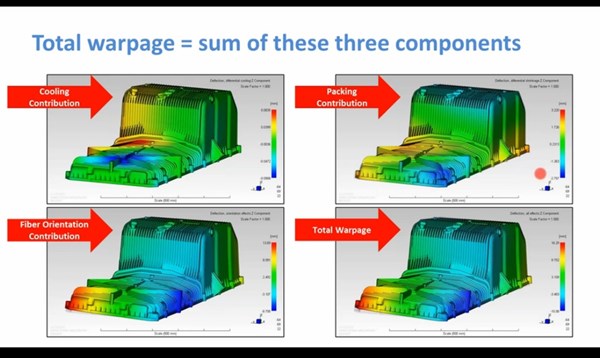What is Your Plastic Pain Point?
Many will agree that one of the most frustrating aspects of plastic injection molding is warping. With that in mind MMT joined a Moldflow engineering services provider in a webinar to show how the manufacture of plastic parts affects their final shape. Take a look at three key questions asked during the discussion, and then view the recording.

Many will agree that one of the most frustrating aspects of plastic injection molding is warping. CAE Services' Director of Engineering, Tim Lankisch took time with MMT during a webinar this fall to explain how the manufacture of plastic parts affects their final shape. Take a look at these three key questions below that were asked during the discussion, and then view the recording.
Question #1 - Why does uniform fiber alignment matter for warpage?
Answer – Uniform fiber alignment is important because we would like to have better control over the shrinkage uniformity. With glass fibers, the shrinkage in the direction of those fibers is usually much lower than the shrinkage in the direction perpendicular to those fibers. Despite that large shrinkage disparity, uniform fiber alignment allows us to have uniform shrinkage that we can control in each of those two directions. Some molders even go the next step and cut shrinkage to different amounts in order to account for this.
Question #2 – Does gate size affect warpage?
Answer – Yes, gate size definitely affects warpage. In fact, not only does the gate size affect warpage, but so does the gate location. The reason boils down to packing. As I said in the webinar, the packing of the part depends not only on the part design, but also the mold design. The distance from the gate to each area of the part determines how much packing pressure each area sees, which in turn determines that area’s shrinkage. If shrinkage is not uniform, then warpage is possible. The gate size also determines how quickly the gate seals, and once it is sealed, it can no longer pack the part. Therefore, if a part requires a longer time to achieve uniform shrinkage, then perhaps the gate size should be increased, or additional gates may be necessary. Simulation helps us determine what the appropriate gate size should be.
Question #3 – How early should analysis be done for warpage?
Answer – Analysis should be done at the earliest stages of product development, even during the earliest concept stage. It is best to do warpage analysis long before tooling is even being considered. This will help us understand the impact of part design, gate location and material selection on the warpage of the part. It also makes it much easier to implement part design changes that we may recommend to improve the warpage.
Click here to view this archived webinar now to find out more!
Related Content
-
How to Select a Mold Temperature Controller
White paper shares how cooling channel analysis, which collects maximum pressure drop, total flow rate and heat dissipation, eases the performance evaluation of mold temperature controllers.
-
How to Analyze and Optimize Cutting Conditions to Reduce Cycle Time
Plastic injection mold design and manufacturing company puts NC program optimization software module to the test. The results were surprising.
-
Four Micro Tooling Considerations
Issues involving gating, ejection, mold splits and direction of pull are of special concern when it comes to micro tooling.
















